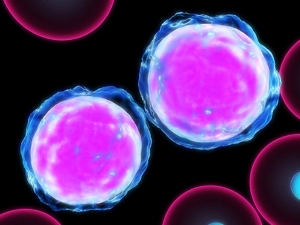A research team at the University of New Mexico has used porous silica nanoparticles and liposomes to develop a high-capacity drug carrier.
Carlee E. Ashley, at the University’s Center for Micro-Engineered Materials who led the team, says the lipid bilayers are called called protocells. They are supported by porous nano-particles, and well suited to carry and deliver multiple drugs administered either individually or as a mixture into the cytosol of the cancer cell.
 UNM's Lipisome-wrapped silica nanoparticles
UNM's Lipisome-wrapped silica nanoparticles
The team joined liposomes to a spherical nanoporous silica core that had a big surface area. The supported lipid bilayer (SLB) that formed was then changed with targeting peptide samples, a fusogenic peptide, and PEG. The PEG makes the carrier stable. The peptides offer binding strength to diseased cells and force the cancer cells to take in protocells. Then they release the drug into the cancer cell.
The nanoporous silica core surface allows the protocells to carry therapeutic and diagnostic medication. This ensures that the protocells release the doxorubicin in a bioactive manner on endocytosis by hepatocellular carcinoma (HCC). The DOPC (1, 2-dioleoyl-sn-glycero-3-phosphocholine)-formulated protocells could deliver half the doxorubicin within four hours and were stable over long periods when stored in artificial body fluids. In contrast, the DOPC liposomes seep out 90% of the doxorubicin within 72 hours and exhibited a discharge report similar to that of the nanoporous core without SLB.
The team says the technique will help deliver the target drug to specific cells, exhibit better cytotoxicity to the target cell, and cause less damage to noncancerous cells. Altering the protocell SLB with ligands that stick to the target cell or overexpressed surface receptors, with a ligand causing internalization, will allow for targeting only specific cells and intracellular delivery to cancer cells where cell receptors are not endocytosed.
The research paper titled, ‘The targeted delivery of multicomponent cargos to cancer cells by nanoporous particle-supported lipid bilayers,’ has appeared in the Nature Materials.